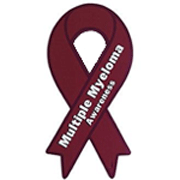Part of getting involved in advocacy and action is learning more about the disease and the cause to improve research, treatment development, supportive care and resources. Multiple myeloma is often a cancer very few have heard of, but once it touches you, you never forget it. In the media, it is often referred to as “bone marrow cancer.” It has touched the lives of many, including some very famous people including the first woman to run for Vice President of the United States, Geraldine Ferraro, and the man many turned to when news crises were occurring, Tom Brokaw.
In technical terms, multiple myeloma is a cancer of plasma cells that is characterized by the overproduction of a monoclonal protein. Symptoms include anemia, kidney problems, high calcium levels and bone loss/fracture.
Recent statistics about multiple myeloma from the National Cancer Institute rank it as number 14 in the list of common cancers. It represents about 1.6 percent of all new cancer cases in the US. Roughly 6.3 individuals per 100,000 will be diagnosed with multiple myeloma.
Risk factors include gender (more men get myeloma), race (high prevalence in African Americans) and age (the median age at diagnosis is 69, with most people being diagnosed between the ages of 65 and 74).

Due to improved diagnostics, the number of cases of multiple myeloma diagnosed annually is going up, but so is the number of treatments available. Multiple myeloma has evolved into a chronic cancer, with survivors living many years after diagnosis. Life goes on, but it is a life with multiple myeloma. The evolution of multiple myeloma becoming a chronic disease has led to a host of long term management issues for patients and caregivers.
The International Myeloma Foundation Nurse Leadership Board identified the following issues requiring special attention for those living with multiple myeloma:
- Bone health and safety
- Safe mobility and physical activity
- Sexual health and dysfunction
- Kidney health
It is important to talk with your healthcare team about the best strategies to manage these challenges in the context of your own multiple myeloma treatment and symptoms.
Team OncoLink has also identified some additional special needs for patients living with multiple myeloma:
- Financial impact of long term treatment
- Psychosocial distress of long term survivorship
- Survivorship care planning
I’m going to focus on these final three elements, as OncoLink has some fantastic resources to help patients with multiple myeloma facing these challenges.
Multiple myeloma patients have the benefit of being supported by multiple copay assistance organizations. Read more about co-pay assistance here. These foundations offer funding for treatment including (in some cases) copays, deductibles and premium assistance. Contact each fund directly to find out if you are eligible and how that fund can best help you pay for your treatment.
Foundations currently (as of March 2016) offering co-pay assistance for patients with multiple myeloma include:
Leukemia and Lymphoma Society Copay Program
Patient Advocate Foundation Copay Relief Program
Cancer Care Copay Assistance Foundation
The availability of these funds is not guaranteed and changes on a regular basis. It is very important to get your applications for co-pay assistance in to these foundations while they are accepting applications and have funds available to help you pay for your care. Your social worker or financial counselor can assist you in completing the applications.

Cancer related distress is defined as any unpleasant feeling, emotion or experience that affects your quality of life, and your ability to cope with your cancer diagnosis and treatment. Distress is a normal and expected side effect of cancer diagnosis, treatment and survivorship.
Distress includes:
- Practical issues/challenges (housing, insurance, transportation, disability)
- Family issues (talking with children, fertility, family support systems)
- Emotional challenges (depression, fear, nervousness, sadness, worry, loss of interest in usual activities)
- Spiritual or religious concerns
- Physical problems (appearance, fatigue, pain, eating, getting around, sexual function, sleep).
When coping with multiple myeloma over an extended period of time, you may face many of these challenges. Oncolink can help! Build your own booklet of educational information on coping with distress and how to get more assistance.
Despite multiple myeloma not being a curative disease at this time, those with multiple myeloma are considered to be cancer survivors. Just because you have multiple myeloma doesn’t mean you don’t need other routine cancer screenings like mammograms and colonoscopy. Your treatments may have short term and late occurring side effects. A survivorship care plan can create a map for you and your healthcare providers to manage your long term survivorship care needs. You can create a survivorship care plan through OncoLink’s online tool, OncoLife.
Taking action for yourself and the management of your multiple myeloma is essential. So, during this month of action, get some support, complete a survivorship care plan and talk to your family and friends about coping with this disease. These actions, at the personal level, are so important to the larger actions that shape funding, research and legislation.
Multiple Myeloma Resources
The Leukemia and Lymphoma Society: Provides disease information, support resources and co-pay assistance. http://www.lls.org/
The International Myeloma Foundation: The International Myeloma Foundation web site provides access to information and services of interest to everyone battling myeloma- patients, their families/caregivers, physicians and scientists. http://myeloma.org/Main.action
Multiple Myeloma Research Foundation: Cutting-edge information on new research and clinical trials for myeloma patients, as well as current treatment information, events for the myeloma community and news from the Foundation. http://www.themmrf.org/
Life with Multiple Myeloma: An online community to support people living with myeloma. http://www.lifewithmultiplemyeloma.org/
Thank you for writing such a good explanation of multiple myeloma and possible long term problems that those of us with myeloma face.